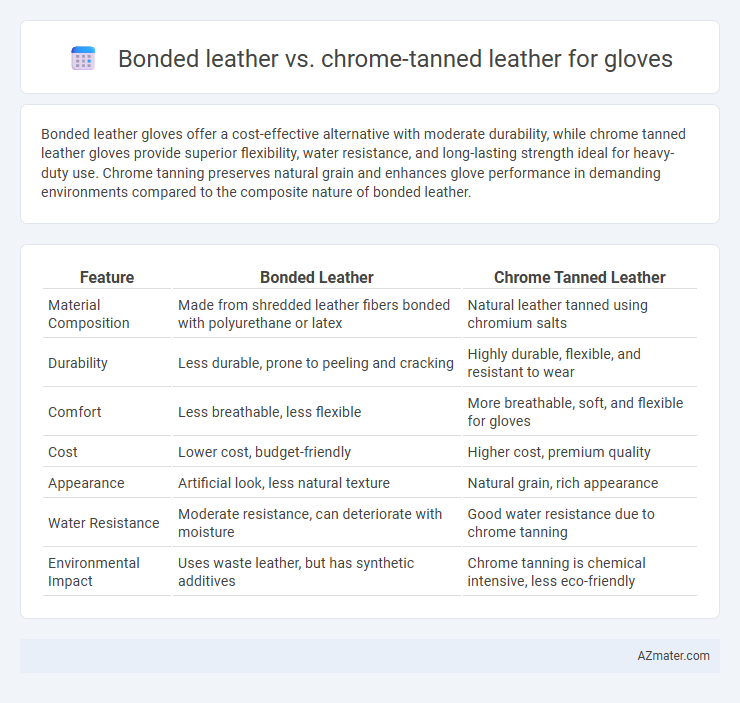Bonded leather gloves offer a cost-effective alternative with moderate durability, while chrome tanned leather gloves provide superior flexibility, water resistance, and long-lasting strength ideal for heavy-duty use. Chrome tanning preserves natural grain and enhances glove performance in demanding environments compared to the composite nature of bonded leather.
Table of Comparison
| Feature | Bonded Leather | Chrome Tanned Leather |
|---|---|---|
| Material Composition | Made from shredded leather fibers bonded with polyurethane or latex | Natural leather tanned using chromium salts |
| Durability | Less durable, prone to peeling and cracking | Highly durable, flexible, and resistant to wear |
| Comfort | Less breathable, less flexible | More breathable, soft, and flexible for gloves |
| Cost | Lower cost, budget-friendly | Higher cost, premium quality |
| Appearance | Artificial look, less natural texture | Natural grain, rich appearance |
| Water Resistance | Moderate resistance, can deteriorate with moisture | Good water resistance due to chrome tanning |
| Environmental Impact | Uses waste leather, but has synthetic additives | Chrome tanning is chemical intensive, less eco-friendly |
Introduction to Bonded Leather and Chrome Tanned Leather
Bonded leather for gloves is made from shredded leather fibers combined with adhesive materials, offering a cost-effective and eco-friendly alternative to traditional leather. Chrome tanned leather involves treating hides with chromium salts, resulting in a soft, durable, and water-resistant material ideal for high-performance gloves. The choice between bonded leather and chrome tanned leather impacts glove durability, comfort, and price, with bonded leather focusing on affordability and chrome tanned leather emphasizing premium quality.
What is Bonded Leather?
Bonded leather is made by combining shredded leather fibers with a polyurethane or latex backing, creating a material that looks like genuine leather but is more affordable and less durable. Chrome tanned leather, in contrast, undergoes a chemical tanning process using chromium salts to produce flexible, water-resistant gloves with superior durability. For gloves, bonded leather offers a cost-effective aesthetic option, while chrome tanned leather provides enhanced longevity and comfort.
What is Chrome Tanned Leather?
Chrome tanned leather is produced using chromium salts, primarily chromium sulfate, which accelerate the tanning process and enhance the leather's durability, flexibility, and water resistance. This method preserves the natural texture and strength of the hide, making chrome tanned leather ideal for gloves that require both comfort and long-lasting wear. Unlike bonded leather, which is made from leather scraps bonded with adhesives, chrome tanned leather maintains the integrity of a single hide, offering superior quality and performance.
Manufacturing Process Comparison
Bonded leather for gloves is created by combining shredded leather fibers with polyurethane or latex binders, resulting in a cost-effective material with lower durability and breathability. Chrome tanned leather undergoes a more complex process involving tanning with chromium salts, which enhances flexibility, water resistance, and longevity, making it preferable for high-performance gloves. The manufacturing of chrome tanned leather is more resource-intensive and requires precise chemical handling compared to the simpler recombination technique of bonded leather.
Durability: Bonded Leather vs Chrome Tanned Leather
Bonded leather is made from shredded leather fibers mixed with polyurethane, resulting in a less durable material prone to peeling and cracking over time. Chrome tanned leather is treated with chromium salts, enhancing flexibility, water resistance, and overall durability, making it more suitable for heavy-duty gloves. For long-lasting performance and resistance to wear, chrome tanned leather outperforms bonded leather significantly.
Comfort and Flexibility in Gloves
Bonded leather gloves offer a lower-cost option with moderate comfort and flexibility but typically lack the breathability and durability of chrome tanned leather. Chrome tanned leather gloves provide superior softness, enhanced flexibility, and better moisture absorption, ensuring greater comfort during extended wear. The tanning process in chrome leather preserves natural leather fibers, making gloves more resilient and adaptable to hand movements compared to bonded leather gloves.
Aesthetic Appeal and Finish
Bonded leather offers a uniform and smooth surface with a consistent color, enhancing the glove's aesthetic appeal through a polished and sleek finish. Chrome tanned leather displays a natural grain and variability, providing a rich texture and depth that contribute to a more luxurious and authentic look. The finish of bonded leather often appears more synthetic, while chrome tanned leather delivers a supple feel and subtle sheen that ages gracefully over time.
Cost Differences
Bonded leather gloves are significantly more cost-effective than chrome tanned leather gloves due to their composition of shredded leather fibers mixed with polyurethane. Chrome tanned leather gloves, made from high-quality hides treated with chromium salts, offer greater durability and flexibility but come at a higher price point. The manufacturing process of bonded leather reduces production costs, making it a budget-friendly option for gloves without the longevity of chrome tanned leather.
Environmental Impact and Sustainability
Bonded leather for gloves is made by combining leather scraps with synthetic materials and adhesives, often resulting in lower durability and increased chemical use, posing greater environmental challenges compared to chrome-tanned leather. Chrome-tanned leather undergoes a chemical-intensive process using chromium salts, which can contaminate water sources if not properly managed, yet it usually lasts longer, reducing the frequency of replacement and waste. Sustainable glove production prefers vegetable-tanned or chrome-tanned leather with effective waste treatment over bonded leather due to the latter's reliance on plastic binders and shorter lifecycle.
Which Leather is Best for Gloves?
Chrome tanned leather is best for gloves due to its durability, flexibility, and water resistance, making it ideal for prolonged wear and protection. Bonded leather, composed of shredded leather fibers bonded with polyurethane, lacks the strength and breathability of chrome tanned leather, resulting in reduced longevity and comfort. For high-performance and long-lasting gloves, chrome tanned leather provides superior quality and resilience.

Infographic: Bonded leather vs Chrome tanned leather for Glove
 azmater.com
azmater.com